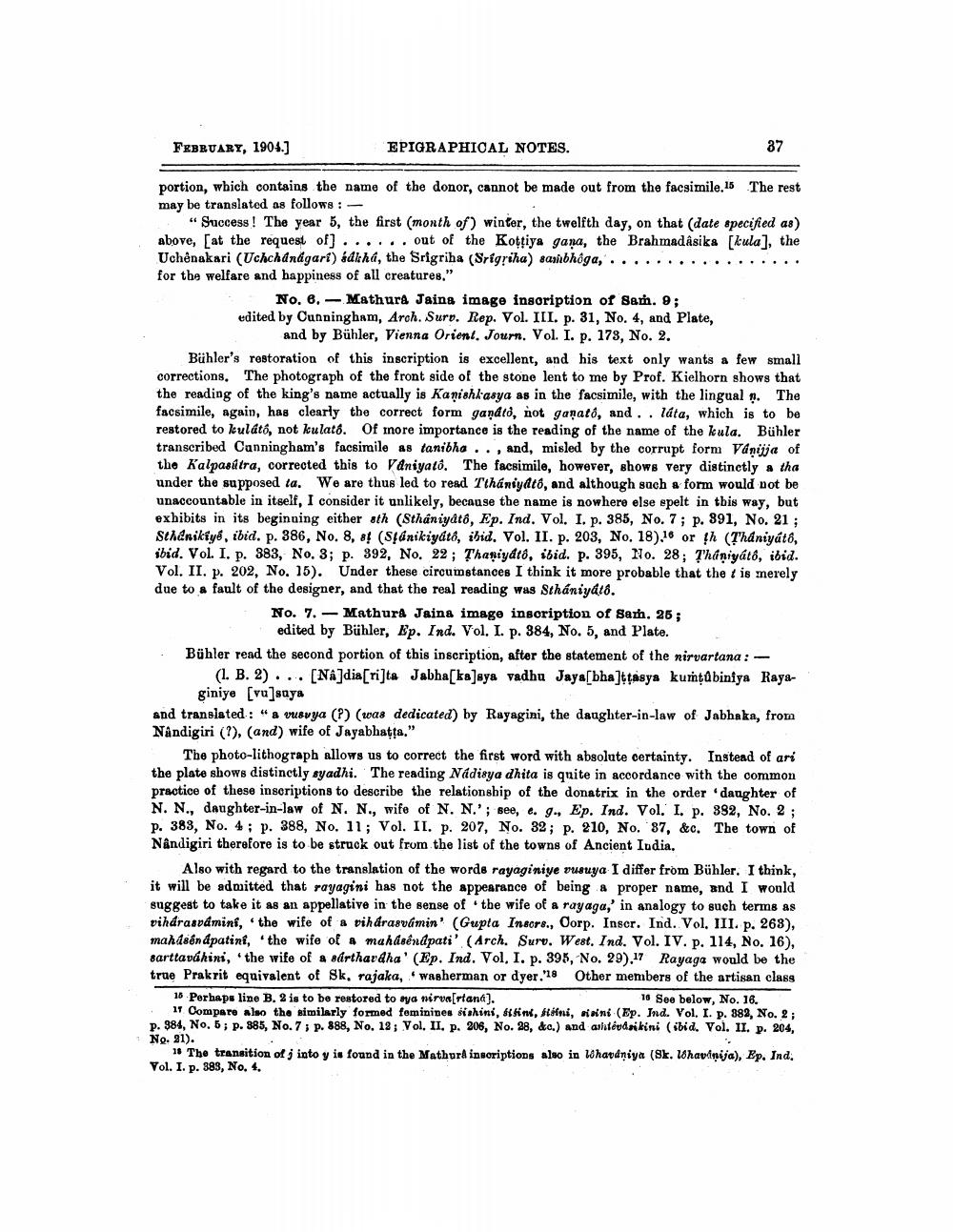________________
FEBRUARY, 1904.)
EPIGRAPHICAL NOTES.
37
portion, which contains the name of the donor, cannot be made out from the facsimile.15 The rest may be translated as follows:
"Success! The year 5, the first month of) winter, the twelfth day, on that (date specified as) above, [at the request of) ...... out of the Kottiya gana, the Brahmadásika [kula], the Uchênakari (Uchchanagari) édkha, the Srigriha (Srigriha) sambhoga, ................. for the welfare and happiness of all creatures."
No. 6, Mathura Jaing image insoription of Sam. 9; edited by Cunningham, Arch. Surp. Rep. Vol. III. p. 31, No. 4, and Plate,
and by Bühler, Vienna Orient. Journ. Vol. I. p. 173, No. 2. Bühler's restoration of this inscription is excellent, and his text only wants a few small corrections. The photograph of the front side of the stone lent to me by Prof. Kielhorn shows that the reading of the king's name actually is Kanishkasya as in the facsimile, with the lingual n. The facsimile, again, has clearly the correct form gandid, not gaṇató, and .. láta, which is to be restored to lulató, not kulató. Of more importance is the reading of the name of the kula. Bühler transcribed Canningham's facsimile as tanibha .., and, misled by the corrupt form Vanija of the Kalpasitra, corrected this to Våniyatd. The facsimile, however, shows very distinctly a tha under the supposed ta. We are thus led to read Tthántydtó, and although sach a form would not be unaccountable in itself, I consider it unlikely, because the name is nowhere else spelt in this way, but exhibits in its beginning either ath (Sthaniyato, Ep. Ind. Vol. I. p. 385, No. 7; p. 891, No. 21 ; Sthanikiya, ibid. p. 386, No. 8, 8! (Sfanikiyata, ibid. Vol. II. p. 203, No. 18),16 or th (Thanivát8. ibid. VOL. I. . 383, No. 3; p. 392, No. 22; Thaniydta, ibid. p. 395, No. 28; Thaniyátó, ibid. Vol. II. p. 202, No. 15). Under these circumstances I think it more probable that the t is merely due to a fault of the designer, and that the real reading was Sthániydi.
No. 7. - Mathura Jaina image inscription of Sam. 25;
edited by Bühler, Ep. Ind. Vol. I. p. 384, No. 5, and Plate. Bühler read the second portion of this inscription, after the statement of the nirvartana:
(1. B. 2) ... [NA]dia[ri]ta Jabha[ka]sya vadhu Jaya[bha]ttasya kumta biniya Raya
giniye (vu]saya and translated : " & vusvya (?) (was dedicated) by Rayagini, the daughter-in-law of Jabhaka, from Nandigiri (?), (and) wife of Jayabhatta."
The photo-lithograph allows us to correct the first word with absolute certainty. Instead of ari the plate shows distinctly syadhi. The reading Nadisya dhita is quite in accordance with the common practice of these inscriptions to describe the relationship of the donatrix in the order daughter of N. N., daughter-in-law of N. N., wife of N. N.'; Bee, e. g., Ep. Ind. Vol. I. p. 892, No. 2; p. 383, No. 4 ; p. 388, No. 11; Vol. II. p. 207, No. 32; p. 210, No. 87, &c. The town of Nândigiri therefore is to be struck out from the list of the towns of Ancient Iudia.
Also with regard to the translation of the words rayaginiye pusuya I differ from Bühler. I think, it will be admitted that rayagini has not the appearance of being a proper name, and I would suggest to take it as an appellative in the sense of the wife of a rayaga,' in analogy to such terms as vihárasvamini, the wife of a vihdrasvamin' (Gupta Incors., Corp. Inser. Ind. Vol. III. p. 268), mahdsendpatini, the wife of a mahdsendpati' (Arch. Surt. West. Ind. Vol. IV. p. 114, No. 16), sarttaváhiri, the wife of a alrthavdha' (Ep. Ind. Vol. I. p. 395, No. 29).17 Rayaga would be the true Prakrit equivalent of Sk, rajaka, washerman or dyer.'18 Other members of the artisan class 15 Perhaps line B. 2 is to be restored to sya nirua[rtaná).
10 See below, No. 16. 17 Compare also the similarly formed feminines sishini, sifint, fišini, saini (Ep. Ind. Vol. I. p. 882, No. 2; p. 984, No. 5, p. 385, No.7, p. 888, No. 12, Vol. II, p. 206, No. 28, &c.) and aihtodaikini (ibid. Vol. II. p. 204, No. 81).
*The transition of jinto y is found in the Mathur inscriptions also in Whavdniya (Sk. Whavinija), Ep. Ind. Yol. I. p. 389, No. 4.




